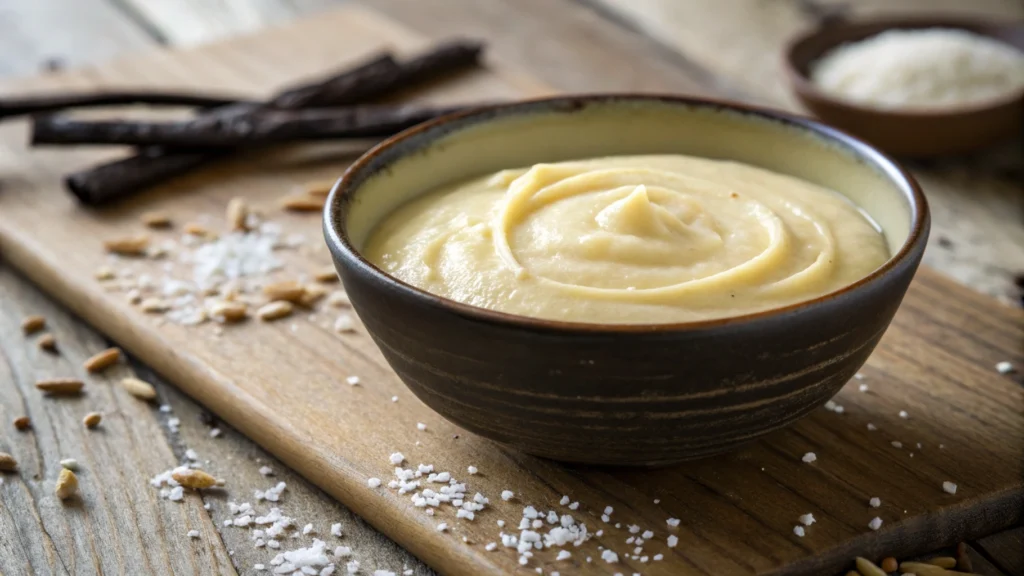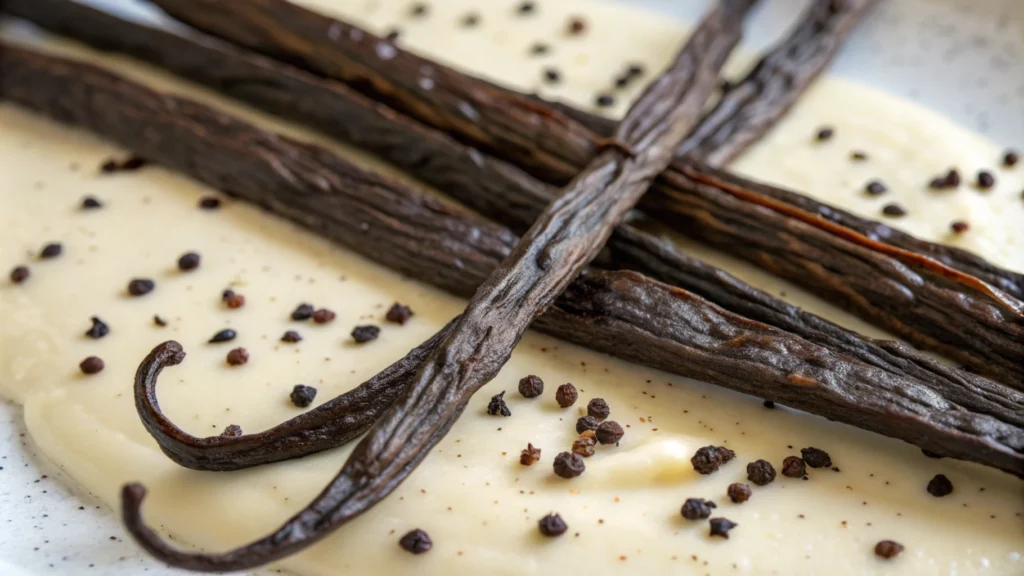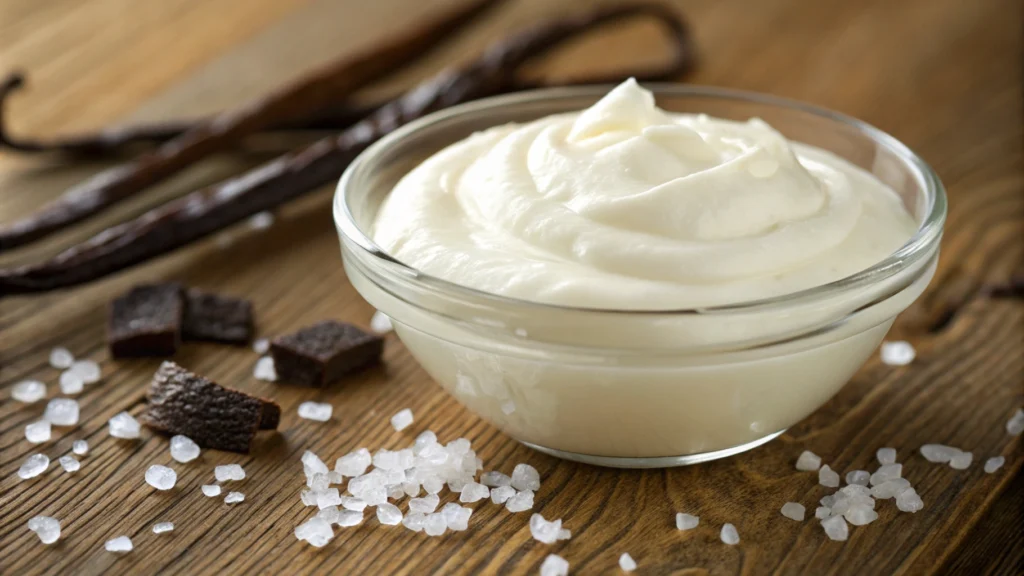Crème brûlée is a beloved French dessert loved by many. It has a silky custard base and a crunchy caramelized sugar top. Choosing the right cream is key to making it perfect.
This guide will help you pick the best cream for your crème brûlée. We’ll look at its history, the role of cream, and expert tips. You’ll learn how to make it as good as the ones in French patisseries.

Key Takeaways
- The choice of cream is crucial for achieving the perfect texture and flavor in crème brûlée.
- Understanding the differences between heavy cream and light cream is essential for making the right selection.
- Mixing and heating techniques can also impact the final outcome of your crème brûlée.
- Experimenting with alternative dairy products can provide unique variations on the classic recipe.
- Avoiding common mistakes in cream selection and preparation can help you consistently create restaurant-quality crème brûlée at home.
Understanding the Basics of Crème Brûlée
Crème brûlée, a classic French dessert, has won the hearts of many. It’s known for its smooth vanilla bean custard and a crunchy caramel top. This dessert has a long history, loved for centuries.
If you’re wondering, What is the secret to crème brûlée, it lies in understanding the role of its components. The cream, combined with eggs and sugar, provides a luxurious mouthfeel, while the sugar topping adds a delightful crunch.
The History of this Classic French Dessert
Crème brûlée started in 17th-century France, called “burnt cream” back then. It became famous in top French restaurants and homes. Now, it’s a favorite baking classic, loved for its creamy custard and crunchy sugar topping.
Key Components of Perfect Crème Brûlée
A great crème brûlée has two main parts: the custard and the caramelized sugar. The custard, made with eggs, sugar, and cream, is silky smooth. The caramelized sugar adds a sweet, smoky flavor and a crunchy texture.
The Role of Cream in Texture and Flavor
Cream is key to crème brûlée’s texture and taste. The type and quality of cream used can change the custard’s smoothness and richness. Knowing how to choose the right cream is crucial for a perfect crème brûlée.

What Type of Cream is Best for Crème Brûlée?
Choosing the right cream is crucial for making the perfect crème brûlée. This classic French dessert needs a rich, creamy custard base. The type of cream you pick can greatly affect the texture and taste.
Heavy cream is the top choice for an authentic crème . It has a high fat content, around 36-40%. This makes the custard smooth and thick, giving it a luxurious feel.
For a lighter version, you can use light cream or half-and-half. They have about 20% fat. This results in a creamy custard that’s not as rich. Remember, using less fat cream might change how the crème sets and feels.
| Cream Type | Fat Content | Texture and Consistency |
|---|---|---|
| Heavy Cream | 36-40% | Thick, rich, and velvety |
| Light Cream | 20% | Lighter, slightly less creamy |
| Half-and-Half | 10-12% | Thin and less dense |
The cream you choose for your crème depends on what you like and your dietary needs. Heavy cream offers the most indulgent taste. But, light cream or half-and-half can be good if you want to cut down on fat and calories.

“The key to a perfect crème brûlée is finding the right balance between richness and creaminess.”
Heavy Cream vs. Light Cream: Making the Right Choice
Choosing between heavy cream and light cream is key for a great crème brûlée. Each type affects the custard’s texture and taste. Knowing the differences helps make a rich, velvety custard, a hallmark of this French dessert.
Fat Content Comparison
Heavy cream has 36-40% butterfat, while light cream has 18-30%. This fat difference changes the custard’s texture and feel.
Impact on Custard Consistency
Heavy cream makes a custard base richer and more luxurious. Its fat molecules make it smooth and creamy. Light cream, with less fat, makes a custard that’s more delicate but might not hold the caramel topping as well.
Mixing and Heating Properties
Heavy cream is more stable under heat, less likely to curdle. Light cream can be tricky, needing careful mixing and heating to avoid a grainy texture.
| Characteristic | Heavy Cream | Light Cream |
|---|---|---|
| Fat Content | 36-40% | 18-30% |
| Custard Texture | Rich and velvety | Delicate and airy |
| Mixing and Heating | More stable and less prone to curdling | More temperamental, requires careful attention |
Choosing between heavy and light cream depends on your preference. Each cream has unique qualities that can enhance your crème brûlée. This choice will help you achieve the perfect custard base for your dessert.
Using Alternative Dairy Products in Your Crème Brûlée
Creating the perfect baking masterpiece starts with the right dessert recipes. For crème brûlée, the choice of dairy is crucial. Traditional recipes use heavy cream, but there are many alternatives for different diets or tastes.
Coconut cream is a popular choice, adding a tropical flavor to your crème. It’s plant-based and lower in fat, great for vegans or those avoiding lactose. But, it has a unique texture and coconut taste.
Almond milk or cashew milk are also good options. They offer a creamy texture and a hint of nuttiness. But, you might need to tweak the recipe and baking time due to their fat and protein levels.
- Coconut cream – A plant-based alternative that can add a tropical twist to crème brûlée.
- Almond milk or cashew milk – Nut-based options that can mimic the creamy texture of traditional dairy.
- Soy milk – A soy-based milk that can work well in crème, but may require adjustments to achieve the desired consistency.
When trying out different dairy products, remember the fat, viscosity, and baking differences. With some tweaks, you can achieve the rich, velvety texture and flavor of crème brûlée.
The secret to a great crème is balancing the custard base and topping. With creativity and experimentation, you can make a unique dessert that suits many diets and tastes.
Common Mistakes When Selecting Cream for Crème Brûlée
Making a perfect crème brûlée needs careful attention, especially when picking the cream. Even experienced chefs can make mistakes with heavy cream. Let’s look at the most common errors to avoid when picking the best cream for your dessert.
Temperature Considerations
The temperature of the custard is key for its texture. If the cream is too cold, it can be lumpy. If it’s too hot, it might curdle. The cream should be between 70°F and 80°F (21°C to 27°C) before mixing it into the custard.
Storage and Freshness Guidelines
Keeping the cream fresh is important. Store the heavy cream in an airtight container in the fridge. It can stay fresh for up to 7 days. Don’t use cream that’s past its expiration date or has been out too long. It can affect the taste and texture of your crème.
Mixing Techniques to Avoid
- Don’t overmix the cream. It can make the custard too light and airy.
- Whisking too hard can cause the cream to curdle, making it grainy.
- Mixing too fast can prevent the flavors from blending well, making the dessert taste flat.
By avoiding these common mistakes, you can pick the right heavy cream for your crème. This ensures it’s rich, creamy, and full of flavor, making it a true treat.
Professional Tips for Cream Selection and Preparation
Creating the perfect crème brûlée starts with the cream. Professional chefs know the secret to making it just right. They’re ready to share their tips to help you make it at home.
First, choose the best cream you can find. Look for high-fat vanilla bean cream for a richer taste. Don’t use non-dairy options, as they can’t match the real cream’s feel.
- Add vanilla bean for extra flavor. Split a vanilla bean and let it soak in the cream as it heats. This adds a deep vanilla taste to your custard.
- Learn to temper the eggs. Warm the egg yolks before mixing them with hot cream. This makes the custard smooth and prevents it from curdling.
- Be patient when baking. Take your time to bake the crème brûlée slowly. This ensures it stays creamy and custard-like.
Follow these tips to make crème brûlée that’s as good as the bakery’s. Enjoy the creamy vanilla bean taste and the crunchy caramel top.
FAQ
What is the best type of cream for making crème brûlée?
Heavy cream is the top pick for crème brûlée. It has a fat content of 36-40%. This makes the custard rich and velvety.
Can I use light cream or half-and-half instead of heavy cream?
You can use light cream or half-and-half, but heavy cream is best. It has more fat, making the custard creamier and richer.
Do I need to use a vanilla bean for crème brûlée?
Using a vanilla bean is optional but adds flavor. The seeds from the bean give the custard depth. If you don’t have a vanilla bean, vanilla extract works too.
How do I avoid lumps in my crème brûlée custard?
To avoid lumps, temper the egg yolks slowly into the hot cream. Strain the custard before baking to remove any lumps or impurities.
Can I use alternative dairy products, such as plant-based creams, in my crème brûlée?
Yes, you can use plant-based creams like almond milk or coconut cream. But, the texture and taste might differ from traditional crème brûlée.
How do I properly store leftover crème brûlée?
Crème brûlée is best eaten fresh. If you have leftovers, store them in the fridge for 3-4 days. Wait to caramelize the top until just before serving for the best texture.
Conclusion
We’ve looked into why picking the right cream is key for crème brûlée. We’ve covered its history, the main parts of the dessert, and the differences between heavy and light cream. Now, you know how to choose the best cream for your custard.
Choosing the right cream and knowing how to prepare it are crucial for a great crème brûlée at home. By focusing on fat content, consistency, and mixing, your dessert can be as good as those in top patisseries. The secret to a fantastic crème brûlée is in the quality and balance of the custard.
With this knowledge, try out different creams and improve your crème brûlée recipes. Dive into the world of dessert recipes and custard and enjoy making this classic French treat at home. Bon appétit!


1 thought on “Best Cream for Crème Brûlée: What to Choose”